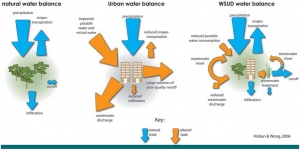Difference between revisions of "Integrated water management"
| Line 3: | Line 3: | ||
== The One Water Approach == | == The One Water Approach == | ||
| − | The One Water approach is predicated on the fact that drinking water, wastewater and stormwater systems share intrinsic connections, and that none of these systems can be managed in isolation from one another. The ultimate goal of the One Water approach is to mimic the natural hydrologic cycle. The figure to the right illustrates how different hydrologic components are altered as progressive urbanization occurs. The Water Sensitive Urban Design (WSUD) panel illustrates how the pre-development water balance can be largely maintained using the One Water approach (note: WSUD is a term commonly used in the Middle East and Australia, and is similar is nature to the term LID, which is the most-commonly used term in North America). In the natural hydrologic cycle, evapotranspiration and infiltration are the dominant pathways within the hydrologic cycle, and as a result this condition produces relatively little runoff. In urban environments, a rise in impervious surfaces coupled with a net loss of vegetation (interception storage and evapotranspiration) and the implementation of a dense storm sewer network significantly reduce evapotranspiration and infiltration and produce large amounts of urban runoff in much shorter timeframes. Within the urban water balance, piped and/or pumped potable water and wastewater discharges are also represented within the cycle. | + | [[File:Hoban and Wong.jpg|thumb|Changes in the relative magnitude of various hydrologic pathways resulting from land use and water management decisions. (Image credit: Healthy Waterways)]] |
| − | + | The One Water approach is predicated on the fact that drinking water, wastewater and stormwater systems share intrinsic connections, and that none of these systems can be managed in isolation from one another. The ultimate goal of the One Water approach is to mimic the natural hydrologic cycle. The figure to the right illustrates how different hydrologic components are altered as progressive urbanization occurs. The Water Sensitive Urban Design (WSUD) panel illustrates how the pre-development water balance can be largely maintained using the One Water approach (note: WSUD is a term commonly used in the Middle East and Australia, and is similar is nature to the term LID, which is the most-commonly used term in North America). In the natural hydrologic cycle, evapotranspiration and infiltration are the dominant pathways within the hydrologic cycle, and as a result this condition produces relatively little runoff. In urban environments, a rise in impervious surfaces coupled with a net loss of vegetation (interception storage and evapotranspiration) and the implementation of a dense storm sewer network significantly reduce evapotranspiration and infiltration and produce large amounts of urban runoff in much shorter timeframes. Within the urban water balance, piped and/or pumped potable water and wastewater discharges are also represented within the cycle. | |
Revision as of 21:27, 17 September 2017
Introduction[edit]
Historic approaches to stormwater management – which initially focused on conveyance, followed by flood control and eventually some aspects of water quality – failed to address the full range of water resources related issues associated with stormwater runoff. To adequately deal with changes to the volume, rate and timing of runoff, and to design source, conveyance and end-of-pipe controls capable of satisfying groundwater recharge, water quality, variable environmental flow targets, and other goals, a holistic, integrated approach to stormwater planning and management is required. To achieve this, a robust, interdisciplinary team consisting of infrastructure planners, water resources engineers, geomorphologists, hydrogeologists, ecologists, fisheries biologists, landscape architects and others must come together in order to define key targets and resource management goals underpinning the One Water approach.
The One Water Approach[edit]
The One Water approach is predicated on the fact that drinking water, wastewater and stormwater systems share intrinsic connections, and that none of these systems can be managed in isolation from one another. The ultimate goal of the One Water approach is to mimic the natural hydrologic cycle. The figure to the right illustrates how different hydrologic components are altered as progressive urbanization occurs. The Water Sensitive Urban Design (WSUD) panel illustrates how the pre-development water balance can be largely maintained using the One Water approach (note: WSUD is a term commonly used in the Middle East and Australia, and is similar is nature to the term LID, which is the most-commonly used term in North America). In the natural hydrologic cycle, evapotranspiration and infiltration are the dominant pathways within the hydrologic cycle, and as a result this condition produces relatively little runoff. In urban environments, a rise in impervious surfaces coupled with a net loss of vegetation (interception storage and evapotranspiration) and the implementation of a dense storm sewer network significantly reduce evapotranspiration and infiltration and produce large amounts of urban runoff in much shorter timeframes. Within the urban water balance, piped and/or pumped potable water and wastewater discharges are also represented within the cycle.
